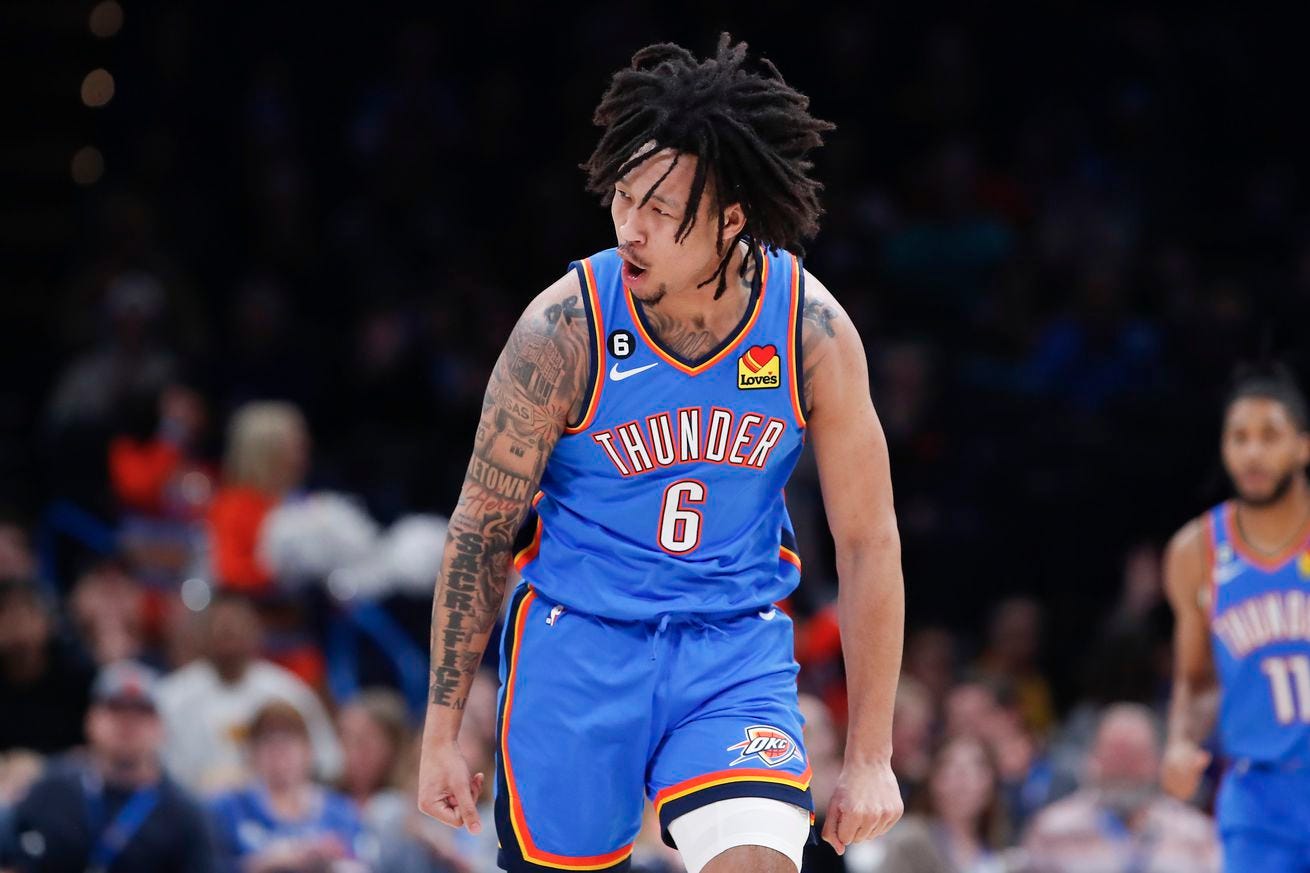Analysis of the Oklahoma City’s Thunder approach to defense
OKC pressure the ball, sink down to the paint and allow corner threes
Over the course of the season, the Thunder have been a tough, stingy defensive unit. OKC are 10th in defensive rating and have achieved this statistical feat while being one of the youngest teams in the league.
Young teams are typically terrible on defense and generally struggle to get stops consistently. Unlike offense, defense requires co-ordination and teamwork among all five players on the court at any one time. This is the aspect of the game that young players can tend to have issues with, good defense needs constant attention.
Somehow, the Thunder have managed the buck this trend and play excellently on the less glamorous end of the floor without having a traditional rim protector for large stretches of the season.
Ever since Aleksej Pokusevski went down with injury in 2022, Coach Daigneault has slotted a variety of options in at center with none of them really being rim protectors. Jaylin Williams comes the closest to this archetype but I would argue his skill lies in his ability to step up and take charges.
It is hugely impressive and the Thunder’s success stems from the constant ball pressure applied by the perimeter players. Gilgeous-Alexander, Giddey, J-Dub and Dort all rotate tirelessly and work together to ensure that there are no cracks in the perimeter defense.
Daigneault’s principles for defense can be broadly summed up into two categories. The first principle relates to how the Thunder drain the shot clock and press the opposition. Luguentz Dort leads the press by picking up his man at half-court and forcing them to pick up their dribble.
Dort is tenacious in how he harries the other team, it is particularly impressive when you consider that there is little statistical reward for his work. Steals and blocks can be quantified easily and you can get a good idea of how a player performs on defense. It is significantly more difficult to measure the seconds drained off the shot clock.
After Dort comes the second line of defense; Shai Gilgeous-Alexander usually slots into this role. Gilgeous-Alexander has quick, deft hands and is adept at swiping the ball away from the opposition. Coach Daigneault puts Shai in a position where he can disrupt the opposition and get the Thunder moving in transition.
The back-court press aggressively and play a proactive brand of basketball. It is a different story for the forward line. The ball pressure is dialled back slightly, there is less emphasis on creating turnovers, more of an emphasis on controlling space. Jalen Williams and Josh Giddey are responsible for sinking down towards the painted area and squeezing the space.
The Thunder’s pressure disorganises the opposing team and prevents a high volume of shots inside. By controlling the painted area, Oklahoma City take a valuable scoring zone off the table and manage the tempo of the game.
The first principle of the Thunder’s defense feeds into the second principle. Sinking down to the paint means that there is a lot of space on the perimeter for the opposing team particularly in drive and kick situations. You would expect the Thunder to give up a lot of open looks from downtown and get torched on a nightly basis.
This has not been the case and the Thunder’s principle of rotating to the next man has been crucial in preventing open looks. Oklahoma City play a form of ‘read and react’ defense in which the players on the court work out where the open man is and rotate accordingly.
If you imagine a clock, the Thunder’s approach to rotations becomes easier to understand. Most teams try to avoid unnecessary rotations and will therefore have help rotations that cover significant distance. It is not surprising to see a player in the painted area rotate all the way to the break.
Using the clock analogy, the player goes all the way from 6:00 to 8:00 for most teams. The Thunder do things differently and ask each player to move just one hour. If we take Jaylin Williams as the example, J-Will will go from the paint (6:00) to the deep corner (7:00) while J-Dub makes a simultaneous rotation from 7:00 to 8:00 (the right break).
The Thunder rotate often over short distances rather than the normal few rotations over longer distances. This change in approach is one of the reasons why the Thunder are able to maintain ball pressure inside while also having sufficient help defense.
We have seen defenses built with similar principles do well in the playoffs, the Bucks won the championship in 2021 by making interior defense a priority. That being said, there are trade-offs with the Thunder’s approach. Oklahoma City are fourth in the league in corner threes conceded per game as per Cleaning the Glass.
The whirling storm of rotations is effective for above the break threes and for below the arc but it is less effective for corner threes. The Thunder will happily help one pass away and leave shooters open with a lot of space.
To date, the Thunder have not been punished for allowing a high-volume of corner threes. Oklahoma City are sixth in the league in defensive field goal for 3-point attempts. However, it is an approach with a lot of variance and there is always the concern that shooters will get hot when they are allowed space.
Oklahoma City’s approach is unorthodox but I think the trade-off is worth it. The Thunder’s success in defending the interior is keeping the team afloat as they push for a play-in berth. Changing the scheme to guard the corner three more closely would mean sacrificing some of that stoutness.




